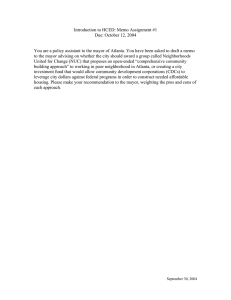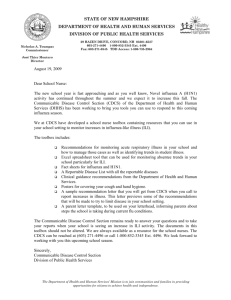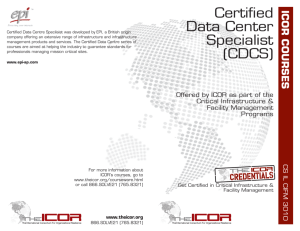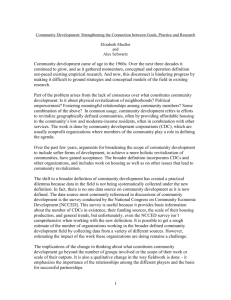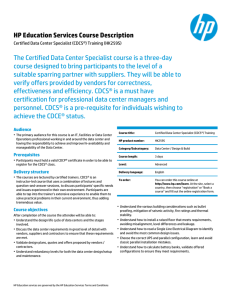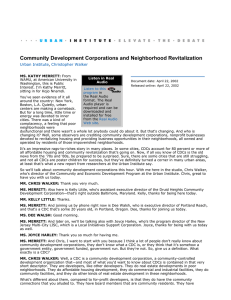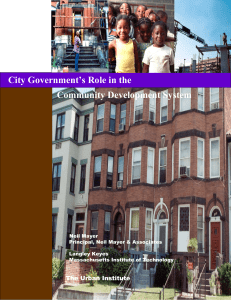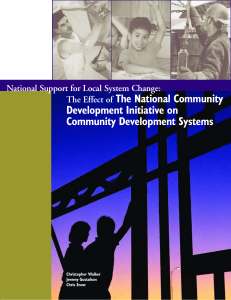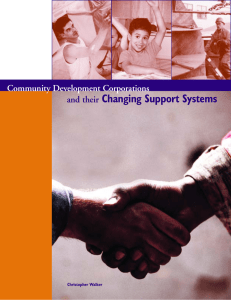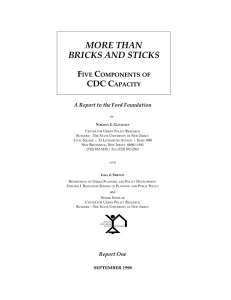Memorandum To: Mayor Shirley Franklin From: Policy Assistant
advertisement
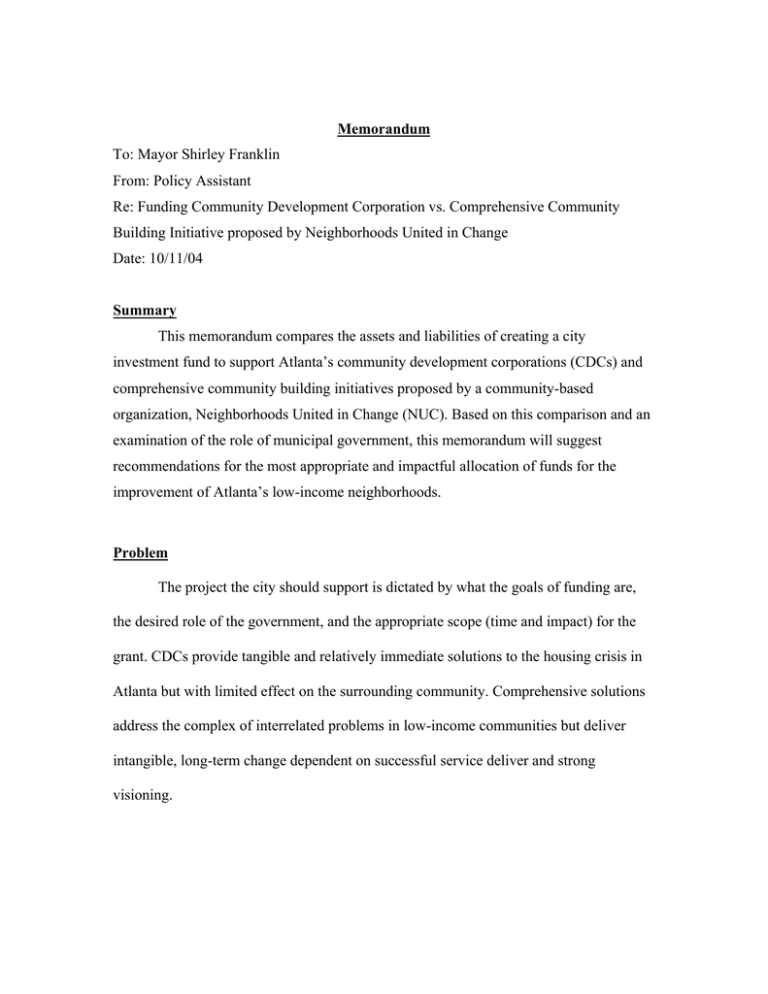
Memorandum To: Mayor Shirley Franklin From: Policy Assistant Re: Funding Community Development Corporation vs. Comprehensive Community Building Initiative proposed by Neighborhoods United in Change Date: 10/11/04 Summary This memorandum compares the assets and liabilities of creating a city investment fund to support Atlanta’s community development corporations (CDCs) and comprehensive community building initiatives proposed by a community-based organization, Neighborhoods United in Change (NUC). Based on this comparison and an examination of the role of municipal government, this memorandum will suggest recommendations for the most appropriate and impactful allocation of funds for the improvement of Atlanta’s low-income neighborhoods. Problem The project the city should support is dictated by what the goals of funding are, the desired role of the government, and the appropriate scope (time and impact) for the grant. CDCs provide tangible and relatively immediate solutions to the housing crisis in Atlanta but with limited effect on the surrounding community. Comprehensive solutions address the complex of interrelated problems in low-income communities but deliver intangible, long-term change dependent on successful service deliver and strong visioning. Context Community Development Corporations: Assets and Liabilities Community Development Corporations (CDCs) have been an important part of community development for decades, fueled by increased federal funding after the government scaled back their affordable housing program. Primarily focusing on increasing the affordable housing stock in a community, CDCs also pursue social objectives that range from community services to community empowerment schemes. CDCs demonstrate several assets worthy of municipal funding. These organizations allow cities an opportunity to support housing creation without acquiring the full financial and administrative burden. Through this type of funding Atlanta can support a relatively quick and tangible community development project that will come to fruition during this political term. CDCs also pursue social goals through mechanisms, such as boards comprised of community members, which facilitate community empowerment. The liabilities of the work of CDCs temper the assets of the method. Despite CDCs increasing success in providing housing, many have criticized their work as ineffective and too narrow in both their housing and social endeavors. Most CDCs are not able to significantly increase affordable housing stock due to insufficient staff, time, and resources. Furthermore, CDCs are only able to secure erratic community participation and funding. Clearly, these organizations struggle to engage social capital and establish social programs, and funders are reluctant to fund such efforts. Funding further confounds CDCs’ social programs because securing operational funding is difficult in comparison to funding for housing initiatives. Thus, while the 1 scope of a project may be more comprehensive, the lack of funding for the necessary staff and resources makes it difficult to realize the full scope of project goals. In light of such funding prejudices, providing a grant that a CDC can use to leverage against government funds for housing construction may not be the type of funding that would be most beneficial for community development corporations. Comprehensive Community Building Initiatives: Assets and Liabilities Historically, comprehensive community building initiatives have received less government attention and funding than CDCs but have recently gained saliency. The comprehensive model aims to create extensive social change through a variety of means, including providing services and creating skill-building opportunities for residents. While some of the objectives can include the “bricks and mortar” projects of CDCs, they also explicitly include building social capital and directly empowering community members. The comprehensive approach presents several assets. Community organizations, such as NUC, are well poised to implement comprehensive change because they are predicated on engaging community members extensively and collaborating considerably with businesses, non-profit organizations, and government agencies. In addition, although the time scale of this initiatives goes beyond this mayoral term, the protracted nature of the project firmly entrenches municipal support for improving poor neighborhoods and guarantees NUC’s long-term engagement in the community and commitment to real change. Furthermore, while the goal of broad social change is difficult to measure, the small steps that create that change, such as a day care center or job training program, are tangible short-term goals by which to measure success. Lastly, NUC’s proposal differs from the CDC plan because its plans are always specifically 2 directed at poor communities and residents to increase equity. With changes in the vision of affordable housing, a CDC may pursue mixed-income housing in their development projects, dictated by the terms of their federal funding. Such projects may actually displace poor residents and can harm the position of low-income community members. Because success in this process relies on substantial community involvement and dynamic interaction between actors from many sectors of society, several liabilities weaken the comprehensive community building method. Firstly, the agenda is both implemented and developed incrementally and organically, requiring a strong vision. Such a method mandates that the NUC steering committee is able to both understand the needs of the community and deliver services in the short-term while designing programs to address some of the long-term, fundamental issues of the community. Secondly, collaboration is at the crux of NUC’s success. Staff must be particularly adept at identifying key relationships and establishing positive, strategic partnerships. In pursuing a comprehensive plan, organizations must be sensitive to the work and agendas of other groups and skillful in establishing mutually beneficial relationships. Lastly, an approach that includes a variety of actors, many different projects, and results in a range of long term objectives is difficult to fund because the ultimate goals are intangible, difficult to measure, and often take a while to achieve. Recommendations Atlanta’s neighborhood development priorities dictate which method is most appropriate to fund. The CDC project allows our city government to partner in a relatively quick process which will result in a small step toward solving a growing housing problem in our city. In this scenario, the government’s role is to support private 3 endeavors to remedy social problems. The NUC option engages city government in an ongoing process and partnership to impact poor communities over time by providing services and opportunities. This model assumes government has more of an interest and responsibility in remedying social problems. Through this lens, I recommend the city award the grant to Neighborhoods United in Change. While housing in Atlanta is a real problem, so are unemployment, education, and access to services. Not to partner with a grassroots organization that is poised to start working on these issues, would be to miss an opportunity to begin work in an area our government has neglected for many years. In a climate where our federal, state and city governments have increasingly cut funding to services for the poor, private initiatives with the wherewithal to incrementally create change on so many levels must be supported by our city. In order to more fully support the NUC initiative and to ensure that the organization does not succumb to the liabilities of their approach, I recommend that- in addition to awarding NUC the grant- the city establish a “community organization liaison.” The liaison can provide technical expertise in sensitive areas where NUC staff and community participants may need support, such as long term planning and coalition building. Not only must municipal government provide financial support to organizations striving to create change in their neighborhoods, we must also help these groups gain the skills to achieve success. 4
